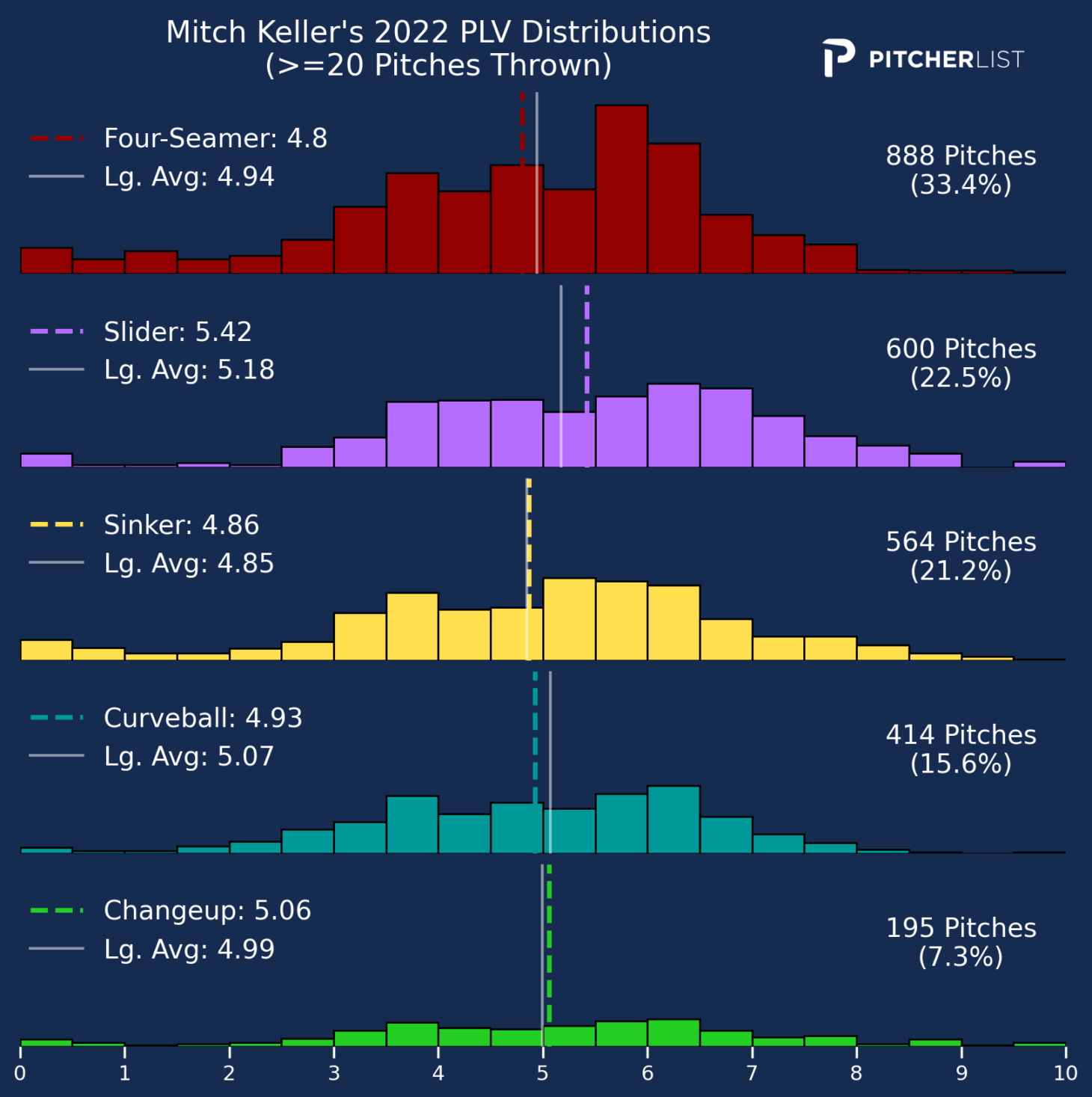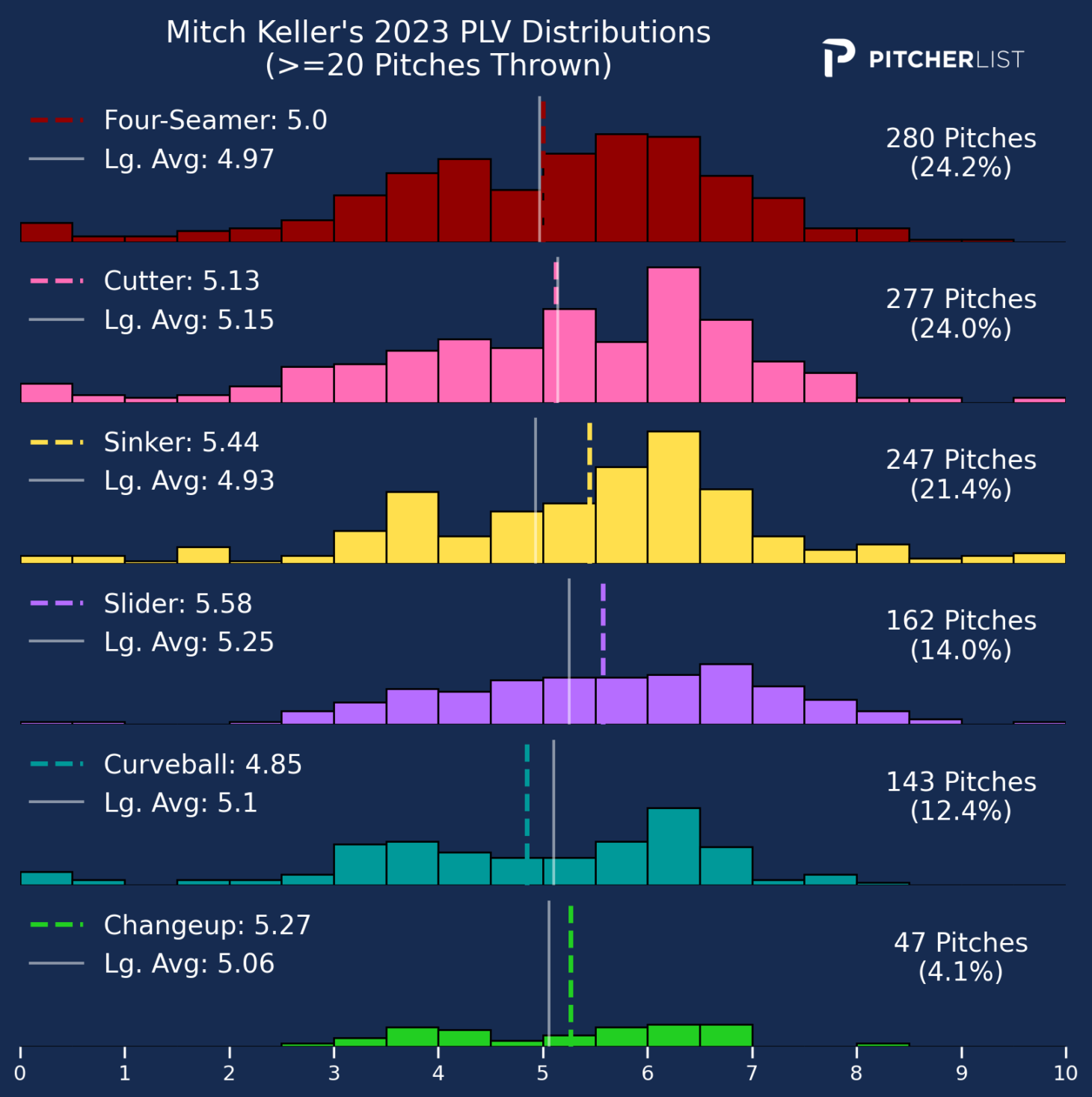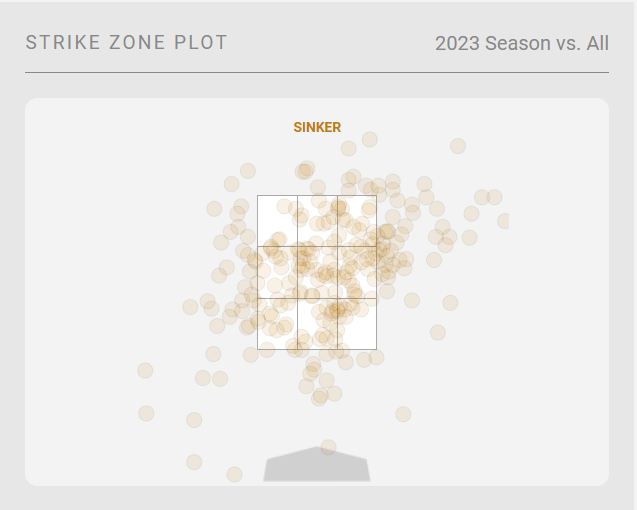For the better part of the past four seasons, the baseball community has struggled to figure out Mitch Keller. The former second-round pick had a lot of hype when he made his debut in 2019. In fact, he was ranked as the Pirates’ top prospect for three straight seasons from 2018 to 2020, per Baseball America.
After a rocky rookie season, where he posted an undeserved 7.13 ERA with a 3.19 FIP, he went to the other extreme in the pandemic-shortened 2020 season, posting an equally undeserved 2.91 ERA with a 6.75 xERA. If pundits hoped the real Keller was somewhere in the middle, he squashed that optimism with a 6.17 ERA in 2021, a season where his strikeout dipped under 20% and his walk rate bloated over 10%.
He showed signs of marginal improvement in 2022, but any arguments for him being a future top-of-the-rotation arm seemed untenable by that point. Prospect fatigue is very real, causing fantasy circles to become collectively done with Keller for 2023.
With an ADP of 388 (117th starting pitcher off the board), he was an afterthought, relegated to waivers for the occasional desperation stream against bottom feeder teams. But now, nearly a third of the way into the season, here are Keller’s stats, compared to his career averages.
The contrast was even more stark a couple of weeks ago when Keller ranked in the top 10 in most pitching stats. Even after a slight stumble to finish the month, his overall numbers this year are pristine. These are all backed by the peripherals, so is it time to say Keller has officially broken out?
In the latest edition of the List, Keller cracked the top-35 starting pitchers, and his ceiling is likely higher if he keeps pitching this way. Let’s dive into how the late-blooming Pirates ace has finally found his way.
Back in early May, following Keller’s complete game shutout against the Rockies, our own Ryan Amore showcased how Keller was taking a page out of Yu Darvish’s book with all the different looks in his arsenal.
But, as Ryan pointed out, throwing more types of pitches doesn’t necessarily work for everyone because it often leads to diminishing returns. There is no cookie-cutter approach for pitchers when selecting what pitches to throw. Many pitchers who start their careers with a kitchen-sink repertoire undergo a rude awakening when their secondary offerings prove ineffective.
The same applies on the other side of the spectrum to two-pitch pitchers, who often need to develop a third offering to succeed. Sometimes less is more, but in Keller’s case, more has been merrier. Mixing up his approach to keep hitters guessing has paid huge dividends in 2023. Let’s compare his pitch mix from last season to now:


Keller’s newly developed cutter has had a domino effect on the rest of his arsenal. While he previously relied on his mediocre four-seamer for nearly a third of his pitches, he has taken steps this year to wean himself off the pitch, with the cutter making up the difference.
Now he has a six-pitch repertoire, with no pitch thrown for more than a quarter of his offerings. His slider is now a sweeper, thanks to some offseason adjustments, leading to an increased horizontal break.
All his offerings are league-average or better, apart from the curveball. Getting into the box against Keller now has truly become a guessing game, as hitters must prepare for a plethora of movement profiles.

That is a smorgasbord of spin directions and varying velocities, which has allowed Keller to maximize his pitch separation. What the batter sees out of the hand ends up being very different by the time it reaches the plate.
The result is the best version of Mitch Keller we have ever seen. He’s inducing more weak contact, painting pitches for called strikes, and missing bats entirely at a career-best pace.
As evidenced by the strikeout and walk numbers, this new Keller is excelling at the one thing that has held him back so far – throwing strikes. So far in 2023, his first strike percentage of 65.4% is a career-best, and his Zone % of 53.6% leads all qualified starting pitchers.
Keller is pitching assertively and trusting his stuff. No more nibbling at the corners or worrying about pitches in the zone getting blasted. Control problems are sometimes mechanical, and other times mental.
Whichever it was that plagued Keller in the past, it seems his mental confidence is now starting to align with his talent.
Fastball Triumvirate
Known for being a fastball-dominant pitcher, Keller’s heater was anything but dominant coming into this year. Compare his average against, weighted on-base-average against, swinging-strike rates, and called strikes + whiffs rate on his four-seam fastball over the last two seasons with 2023.
What changed? Keller has excelled this year on fastballs in the zone and we can quickly connect the dots to see why.
Now equipped with three different fastball shapes, Keller’s varying speeds and movement profiles have kept hitters off-balance. He’s able to jam lefties with the cutter and feature sinkers to the righties, both of which set up the hard, straight four-seam.
This mix has allowed him to decrease his overall four-seam fastball usage, while still maximizing its effectiveness. While the four-seam is improved and the new cutter has been decent, the sinker has been in a tier of its own, registering a fantastic 5.45 PLV, which is in the league’s 93rd percentile. Per Lance Brozdowski, Keller has increased the vertical break on his four-seam, while adding an extra inch of drop on his sinker.
This has created even more pitch separation between the two offerings. His sinker xwOBA is second in the league among qualified starters at .254. What’s most impressive is how he really is accomplishing all of this over the heart of the plate.

A quick look at his sinker plot shows this isn’t exactly a masterclass in pitching to the corners. But this is the epitome of believing in your stuff and daring hitters to swing at it.
In 2023, he’s thrown the sinker in the zone 69.2% of the time and that has led to a whopping 40.1 CSW%. Hitters have not been able to square this pitch up, as they have mustered just a measly 13.7% hard contact rate against.
Now has Keller’s stuff really improved that dramatically, or are hitters just flummoxed by his pitch sequencing? It’s probably a bit of both, and we can explore his growth in the latter area by rolling the tape of an at-bat where all three fastballs are featured.
The unfortunate batter for this exercise is Rockies’ prospect Brenton Doyle, who, despite having a nice start to his major league career, gets picked apart in this at-bat against Keller. Let’s watch how the four-seamer, sinker, and cutter play off each other.
This is a perfect first pitch from Keller – it’s a sinker that paints the bottom part of the zone at 94 mph. Even if Doyle swings, there’s not a whole lot the right-handed hitter can do with this pitch. Pulling this down-and-away pitch is almost an assured groundout to the left side. Pounding the zone with the sinker has been the standard for Keller this year and now he’s ahead in the count, 0-1. Let’s see what he decides to do next.
Keller goes back down to the middle-away location, but this time throws a 91-mph cutter. Doyle recognizes the location and offers at the pitch, only for the ball to break out of the zone. The result is a foul tapper off the end of the bat that bounces harmlessly to the backstop. Perfect sequencing here from Keller, as he shows the sinker first to steal a called strike and then follows it up with the cutter in the same spot to generate an off-balance swing. Now he’s in the driver’s seat, up 0-2.
Good morning, good afternoon, good night. Keller finishes off this sequence with 98 up in the zone, blowing a straight four-seamer right by Doyle for the strikeout. After staying down and away for the first two pitches, Keller changes the eye level with the fastball up and Doyle is simply unable to catch up to the velocity. The location is impeccable, and not one breaking ball was needed. Due to the speed and movement separation from the cutter and sinker, the four-seamer just plays up. It’s the fastball triumvirate in action.
Sweeper Keeper
Of course, it would be remiss to not bring up baseball’s favorite new revolution, the sweeper. Keller has always had a great slider, with the pitch a consistent strength even in past seasons when the overall results didn’t match.
But with some determined offseason work, Keller tapped into the seam-shifted wake phenomenon and added a more laterally oriented sweeper. Considering his curveball still grades out as a subpar pitch, the sweeper is proving to be a real game-changer for Keller. The sweeper features an extra 14 inches of horizontal break and comes in 4 mph slower compared to his original gyro slider.
Here’s a look at the slider in 2022. It has that typical gyro slider movement, as the pitch pretty much drops straight down, with not very much horizontal break. Keller starts this pitch middle-away and that’s basically where it ends up.
Compare this to his sweeper in 2023. It possesses a vastly different shape, with that distinct late sweeping movement. Keller starts this pitch away and the flight of the baseball breaks sharply from one side of the strike zone to the other, freezing Jarred Kelenic at the knees middle-in.
Keller has changed the way he uses the pitch too, typically saving it as a strikeout pitch in two-strike counts. In the past two seasons, Keller threw his slider in two-strike counts about 40% of the time.
This season, with the new sweeper in tow, he’s letting it fly in two-strike counts 55% of the time. This approach has borne impressive results so far. His O-Swing% is up nearly 8% from 2022 and his SwStr% is up about 4%, showing hitters are more liable to chase out of the zone against the new sweeping breaking ball.
This pitch has been devastating on righties, to no one’s surprise, as it often starts over the heart of the plate and ends up in the opposite batter’s box.
Recently though, he’s been using that sweeper against lefties too. Against it, lefties are just 1 for 13 with 5 strikeouts. Knowing Keller’s history of having rough splits against hitters on that side, any new wrinkle to his approach is welcomed.
Overall in 2023, he’s throwing the sweeper just about 13% of the time, down from the 23% slider usage last season. The cutter has made up a large portion of that usage since it shares a similar movement profile as the slider. In this case, less is more, and the sweeper being saved as a strikeout pitch is turning out to be very effective.
It’s a great sign for Keller that, after filling up the zone early with the fastball triumvirate, he has a new new ace in the hole in this nasty breaking ball.
Franchise Ace At Last
Every year, there are at least a couple of post-hype breakout stories that remind us not to write players off so soon. For all the fantasy managers who stuck it out with Keller all this time, congratulations for being the epitome of patience.
Player development is not always linear, especially when factoring in the circumstances of the last few seasons. Just when it seemed Keller would be another unfortunate page in the book of Pirates’ pitching prospects that didn’t pan out, he found the formula for success.
This breakout is legit, from the newfound pitch mix to the improved control, to the overall confidence that he carries to the mound. This development, combined with the dearth of young players stepping up during this surprisingly strong start from Pittsburgh, bodes well for their future.
Despite how the rest of their season plays out, there’s no doubt the Pirates will be flying the Jolly Roger quite often when their ace takes the hill.

